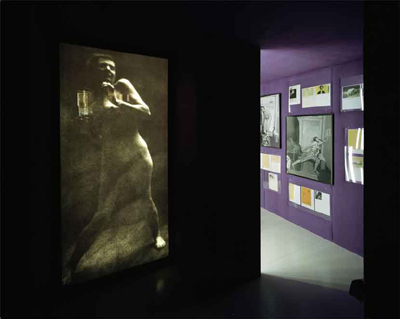 | | Information about the FrL Exhibition at the Cabaret Voltaire [adapted from the "dada haus" website at: http://www.cabaretvoltaire.ch/dada/]
See also Gisi von Freytag-Loringhoven's Impressions of this Exhibition
The Dada Baroness
Elsa von Freytag-Loringhoven: A Life on the Wild Side
An exhibition originally created for Berlin's Literaturhaus,
now adapted for cabaret voltaire in Zurich 
The streets of Berlin, Munich, New York and Paris were her stage, and the name of her programme was Dada. Long before punk, performance art and Andy Warhol were heard of, Elsa von Freytag-Loringhoven (1874-1927) was busy creating her greatest artwork - herself.
Elsa von Freytag-Loringhoven was one of the most ambivalent of all the figures associated with New York Dada. The blasphemous, the obscene, the excremental could not faze her, nor any farting god, nor nuns on wheels. Her disregard for taboos was total, not sparing even her avantgarde friends. For the unapproachable Marcel Duchamp, for instance, whom she challenged to match her creative and sexual prowess, she openly used the sobriquet of 'M'ars' (My Arse). Wilful and headstrong though she was, however, her themes were always absolute ones: love; aging; war; the city. 'I loved the world, because in it I was able to love / I loved the world, because in it I was able to make art.' The fervour with which she was admired and feared during her lifetime - admired for her poetry and feared as a 'freak' - was matched by the promptness with which the world forgot her after her death in 1927.
The Baroness's life story shows the courage that makes for greatness, yet is one of the saddest of any to be found in the whole modern period - rich though it is in desperadoes. At 19, Elsa fled from Swinemünde (Swinoujsce) to Berlin. It was here that she started on the wild odyssey of sexual escapades which were to involve her in bizarre marital relationships and raise her to the aristocracy. Subsequent staging posts on her travels were Munich, Wollerau on Lake Zurich, New York, Berlin again, and Paris. At all times, though, regardless of whether her current style happened to require a brassière made from tomato-pulp tins, or obliged her to wear teaspoon ear-rings, or perhaps black lipstick, the Baroness regarded the boundaries between life and art as thoroughly fluid, just like those between the everyday and the unbelievable, between the creative and the plain dangerous.
In 2002, in a spectacular retrospective, New York celebrated its rediscovery of the Baroness. The Old World has followed suit in 2005, putting on an exhibition in the Literaturhaus in Berlin and also in Zurich's legend-rich cabaret voltaire, the single-celled organism from which all Modernism grew, and which was at the same time the navel of the Dada world. cabaret voltaire is presenting the Berlin exhibition in a condensed, visually rethought version featuring facsimiles and loaned original items, some of them from private collections in the United States. The main focus of interest is the Baroness's New York period and in particular the art-detective work involved in researching the invention of the Readymade. The numerous digitally produced facsimiles relating to her biography and her literary and graphic output are presented using appropriate visual media and integrated into a modern setting. In this way the exhibition avoids placing undue emphasis on background, i.e. on contextualising Elsa von Freytag-Loringhoven's historic acts of pioneering bravado and revolutionary bids for emancipation; it focuses rather on communicating an insight into the existential urge this woman had, as artist, as performer, as poet, for emancipation and self-invention - an aspect never previously presented in accessible form to the general public in Switzerland.
Concept and visual design:
Raimund Meyer, Juri Steiner, Pius Tschumi
Realisation:
Kunstumsetzung GmbH, Zurich
Karin Sartori, Daniel Hunziker, Fabienne Ruppen
Sound: Iris Rennert, Oliver Friedli, Biel, Basel
Speakers: Sabine Falkenburg, Friedhelm Ptok. English texts translated by Carola Veit, with Sabine Büdel, Irene Gammel, Claudia Kotte, Katrin Moch, Lisa Quirke and Ernest Wichner. Sound engineering: Oliver Grossmann; TV+Synchron Berlin GmbH.Items kindly lent by:
Literaturhaus Berlin. Marc Kelman Collection, New York. Francis M. Naumann, Fine Art, LLC, New York. James Joyce Foundation, Zürich. Höfner Volksblatt, Regionalzeitung, Wollerau et al.
We gratefully acknowledge the support given by Elisabeth and Gianni Garzoli |

 | The University of Manitoba Archives
Winnipeg, MB, Canada R3T 2N2, 1-204-474-6483
Questions or Comments? e-mail Gaby Divay
©2006/7 UMArchives & Special Collections | |  | | |



